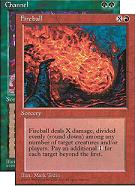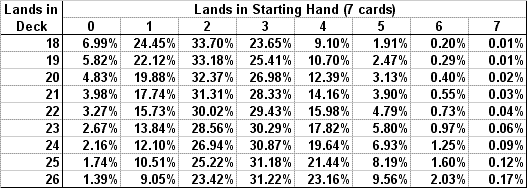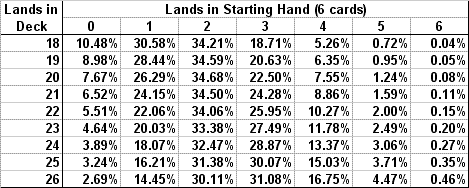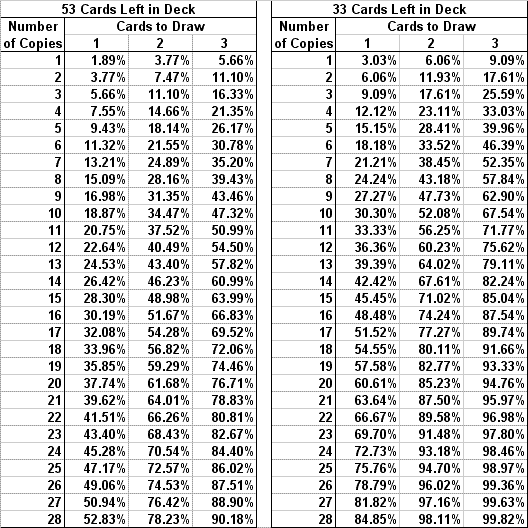
For most players with little tournament experience, it's very easy to underestimate the importance of the mulligan. In fact, a lot of players treat the Paris mulligan as if it were the same as the old all-land/no-land mulligan rule, or even the same as common casual mulligan rules (0, 1, 6, or 7 lands; or free mulligans whenever you want). But veteran tournament players know just how different the Paris mulligan is, and they know that the mulligan decision is yet another critical skill they need to master.
While the old mulligan rule prevented severe mana screws and mana floods, it still left players highly susceptible to weak opening hands (1-land and 6-land, especially). By allowing players to mulligan with any hand, the rules gave players much more control over factors of chance, but of course it had to come with a drawback to avoid mulligan abuse. Drawing one fewer card may seem like a harsh penalty - especially since the idea of card advantage has been pounded into everyone's heads so many times by now - but very often that one card is well worth the chance to draw a new hand.
In general, Magic players tend to be risk-averse, and thus are much more conservative with mulligans than they should be. Of course, the decision to mulligan can very often be tough, but it must be taken seriously. Due to poor mulligan decisions, a player can lose a large percentage of games even before the first land is dropped.

Someone just got dealt
Big Slick.
Since I play Texas Hold 'Em, I often draw parallels between poker and Magic. Deciding whether to mulligan is a lot like selecting your starting hand in Hold 'Em. Some hands are incredibly strong, some simply need to be thrown away, and most are somewhere in between. Of course, you don't get unlimited choices; you eventually need to pick a hand to play with, whether you like it or not.
Just as one can rank starting hands in Hold 'Em, one can also rank starting hands for a given Magic deck. Of course, ranking Magic hands is much more subjective. And just as in poker, the strength of your hand is also dependent on your opponent's hand. A strong starting hand against one aggro deck may also be a terrible hand against some control deck. In order to make proper mulligan decisions, you have to be aware of how to rank your starting hand against any particular deck. And if it's Game 1 and you don't know what your opponent is playing, you should still be able to assess the general strength of your hand.
When you approach the mulligan decision, you want to be thinking of this question: "What is my goal here?" Think about your opponent's deck, and what its expected progress looks like. What is your opponent's fundamental turn (the turn on which he or she effectively wins)? Are you playing the beatdown or control role in this matchup? What do you need to have in order to properly combat your opponent's deck? Once you determine how your deck's progress matches up with your opponent's deck's progress, you face a much easier (and smarter) decision at the start of the game.
Lands, Lands, Lands
One of your fundamental concerns, independent of the matchup, is mana. Every spell in your deck is dependent on you having the right number of lands. But how much is the right number to have in your opening hand? Every player knows that the no-land and all-land hands are auto-mulligans. But what about everything else?
Most decks ideally want 3 to 4 lands in their opening hands. But for even a heavy manabase, this isn't going to happen consistently enough - at most, you're looking at a 50% chance of getting a 3- or 4-land hand on your first try, and a 75% chance of getting it in your first hand or on your first mulligan (6 cards). So it seems that most players have come to the conclusion that anywhere from 2 to 5 lands is the minimum for playability, with the decision dependent on what the nonland cards are.
For reference, here are some probability tables for 60-card and 40-card decks. I haven't bothered including probabilities for mulliganing down to 5, since at that point, you pretty much have to keep it regardless of what you get (unless it's another auto-mulligan).
60-Card Deck




40-Card Deck




Also keep in mind when considering a mulligan how likely you are to draw more land in the next one or two cards. If you have a strong 1-land hand that can really benefit from just one more land, you might consider taking the risk. You also might consider throwing back a 5-land hand due to the fact that you're still likely to draw lands in the next couple turns.
Rule of 2, Rule of 3
There are some simple calculations for estimating your chances of drawing further land. Suppose you have a 60-card deck. After drawing your opening hand, determine how many lands you have left in your deck (call it N). Multiply that number by 2 (so now it's 2N), and that's your estimated probability (as a percentage) of your next card being a land. If you instead multiply the number by 3 (to get 3N), that's your estimated probability of one of your next two cards being a land.
For example, if you have 24 lands in your deck, and your opening hand contains 2 lands, then you have 22 left in your deck. Therefore, you have about a 44% chance of having a land on top of your deck, and about a 66% chance of finding a land in your top two cards.
For a 40-card deck, use the multipliers 3 and 4.5 (instead of 2 and 3). One tip for multiplying by 4.5 is to first multiply by 3, then add half of that. For example, if you have 16 lands left in your deck after your opening hand, then your probabilities are 48% and 72% (48 + half of 48), respectively.
This can also be used when considering color issues. If you have a hand that's short by one mana of a certain color, you can use these rules to see how likely it is to draw a mana source of that color in the next couple cards.
As I mentioned, though, these are only close approximations, and if you want to see your actual probabilities, here's the table. (If you're drawing out of 54 or 34 cards instead, your probabilities will drop by less than 1%.)

Got Mana?
Speaking of color issues, you have to know what the color division is like in your deck if you're playing multiple colors. When looking at just your starting hand, it's generally pretty obvious when you should mulligan a hand due to color issues (such as having 3 lands of one color and 4 spells of another). But what if your starting hand has matching lands and spells, but the cards are in your weaker color? Any card you draw of another color is a dead card until you draw an appropriate land, and if you have several cards with double-color requirements, those might be dead draws for a long time. Even though your stronger color will have more lands devoted to it, there's still a good chance you won't draw one of them soon enough. In some cases, that's not much of a problem, but in some decks, keeping such a hand might be a disaster.
One other mana issue to keep in mind, particularly while building and tweaking your deck, is the cost distribution of your spells. You want to know what spells are available to you at each mana level. Can you expect to do much with only two lands, if you happen to not draw any more? Does your deck need four mana as soon as possible? Are five lands in play too many for your deck? These kinds of questions should be answered before you ever have to make a serious mulligan decision. Then, when you have to actually make the choice in a tournament setting, you can instantly tell whether that two-land hand is good enough for your matchup. This becomes even more important when you're facing an opponent with some form of mana denial.
Assessing the Matchup
Remember the question: "What is my goal here?" Obviously, your goal is to win, but you need to know how you're going to do that. First of all, try to get an idea of what you're up against. In Game 1 of a matchup, you might not know anything, so you'll just have to make your decision based only on your knowledge of your own deck. But once you know what your opponent is playing, you have a lot more information to help you properly mulligan.
Think about your opponent's expected progress and fundamental turn. Is your deck faster or slower? Depending on the answer, you have to determine whether you need to play the beatdown role or the control role in this matchup. This can dramatically affect both your sideboarding choices and your mulligan decision. If you have to play the beatdown, you definitely don't want to keep a slow hand that has no fast threats. Likewise, if you have to play the control, you don't want to keep a hand that's light on answers, and having threats is less important.
Look at the other critical turns in the matchup. Where should you be by turn X? Do you have the cards to get you there? You don't want to keep a hand that will seriously fall behind in development and tempo, or a hand that will run out of steam if you're expecting a long game. While the hand might not spell an auto-loss, you're still giving yourself poor odds for a win.
Does your opponent have any "must-answer" cards? If so, you want to reliably have answers by the time he can play them. If that one card can totally destroy your deck, you'll want to seriously consider aggressively mulliganing for the correct answer.
Note that these are all also factors that need to be considered when you're building your deck. A well-designed deck should already be prepared for a specific game plan, and the mulligan is really a tool for you to help your deck achieve that plan.
Play vs. Draw
How is your mulligan decision affected by playing first or drawing first? There are two things to consider - the tempo and the extra card. First of all, the turn order affects the relative positions of each player's progress curve. Since the progress curves help determine who should play beatdown and who should play control, this difference could mean a shift in roles for a matchup where both decks have similar critical turns. It can also affect the value of specific cards in the matchup. (Is a fourth turn Wrath of God too late when playing second here, and does that make cheaper spot removal more important to have in the opening hand instead?) Fortunately, this won't affect most of your mulliganing decisions, but it's an additional consideration for a matchup that is heavily demanding on your deck's speed.
The more relevant difference between going first and going second is the extra card. When you're on the draw, you're essentially starting with 8 in your hand, and that can make a lot of hands much more playable, despite being behind in tempo. When holding a borderline hand that's missing a single piece (whether a land, answer, threat, etc.), the extra card may bump up its playability since you're very likely to find that piece. However, this should only be a consideration if you have a large number of copies (such as lands, or several similar spells) and you won't need the card until the third turn at least, since you'll get at least three chances to draw that card. If you need the piece right away, don't count on being able to get it. Trying to catch a second land with only two draws is a very risky proposition. For reference, take a look at the chart earlier in this article.
Be careful, though - the additional probability is not a guarantee, so don't keep a weak hand if the missing piece will only make it barely playable. Only consider keeping the hand if the missing piece will make it very playable. Even then, you have to think about how your hand will fare if you don't get your missing piece.
Being on the draw can also improve a land-light hand that has early-game spells to cast. For example, if you only have two lands, but three good spells that you can play with those lands, then there's not too much risk in keeping the hand. You can at least develop in the early turns while waiting on a third land and appropriate spells.

As with any decision you ever make, you can look at your mulligans from a risk-versus-reward standpoint. A lot of the discussion above implicitly makes use of risk-reward analysis: throwing out hands with too few or too many lands, comparing expected progress, keeping weaker hands on the draw, and so on. All of these things rely on the fact that it is better to throw away a hand if, on average, you can expect to get something better. That's known as having a positive expected value.
The basic idea is this: your initial hand has some expected chance of winning the game in a particular matchup. Compare that win rate to the range of hands you can get if you mulligan. If you're more likely to get a better win rate than your current one, then you should mulligan.
Because the set of 6-card hands is inferior to the set of 7-card hands (meaning that the best 6-card hand is worse than the best 7-card hand, and the same applies for the worst hand), you have to have a pretty bad 7-card hand to consider mulliganing. And it still applies when considering a second or third mulligan. There are the obvious bad hands (the 0-land and the 7-land), but most of the time you'll be presented with a hand that's seemingly decent.
Now you have to think to yourself, "What is my estimated probability of winning the game with this hand?" This takes a lot of experience with your deck, as you have to consider all your possible paths of progress, what kinds of cards you might draw into, and what kinds of obstacles your opponent will place in front of you. It will certainly help to have analyzed the matchup long before the actual game. Then, once you have determined your likelihood of winning, think about what your deck's 6-card hands are like. Are you more likely to get a 6-card hand with a better win rate, or are you more likely to get a dud and be forced to drop to 5 cards?
In reality, though, if your hand is very strong in the matchup, there's no reason to throw it away even if you will average a better hand post-mulligan. This is why you have to focus on the risk just as much as the reward. If you already have a strong hand for the matchup, you don't want to take the chance of getting an awful hand just for the possibility of improving your win rate by a couple percentage points. Your potential loss (losing the match entirely due to bad mulligans) is much greater than your potential gain (having a slightly better chance of winning). As the saying goes, quit while you're ahead.
One Last Piece of Advice
There really aren't many absolute rules when it comes to making your mulligan decision. You have to pay attention to your matchup and the possibilities of your hand to be able to make the correct choice. It can be very tough to properly evaluate your hand very quickly, but it's very necessary if you want to improve your chances of winning.
A lot of top players recommend keeping track of tough hands so that you can discuss them later on with your teammates or other players. Get in the habit of analyzing your decisions; it'll make you better and faster. Think about what you might have overlooked or what you might have taken for granted. Honestly evaluate whether you're being too conservative or too loose. Although studying the game will help you be the best at Magic, you also have to be willing to study yourself.
-fadeblue
Credits: Binary (editing), iloveatogs (banner)
Comments